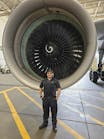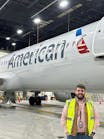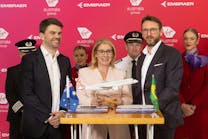Two Years After Second 737 Max Crash, Have Boeing and the FAA Changed Enough?
Mar. 10—On Wednesday, a dogged group will gather for a vigil outside the Federal Aviation Administration ( FAA) headquarters in Washington, D.C., to mark the two-year anniversary of the death of their loved ones in the second crash of a Boeing 737 MAX.
The same day, an American Airlines 737 MAX is scheduled to take off from nearby Reagan National Airport, one of more than 100 of the jets now routinely flying worldwide.
Boeing has fixed the jet's flawed flight-control system and the FAA has allowed the MAX back in the air. Yet after multiple investigations revealed failures both in the airplane's design and in the oversight process, both the jet maker and the safety agency still face intense scrutiny and calls for more accountability.
Meanwhile, the emotional impact of the tragedies in Indonesia and Ethiopia has been profound and personal.
Zipporah Kuria, who lost her father, Joseph Kuria Waithaka, in the Ethiopian Airlines crash on March 10, 2019, will remember him Wednesday in a small family gathering where she lives near Hull in England.
"It's unreal how Boeing and the rest of the world is moving on," Kuria said in an interview. Active in a campaign to keep the MAX from flying again, Kuria says she feels "a sense of defeat and hopelessness that the plane is back in the air."
Inside Boeing, where employees at every level routinely put their own families on board the airplanes they design and build, the emotion is less raw but still deeply felt.
A recently retired senior engineering executive at Boeing said that when he walked around the Everett design center after the crashes and talked to his engineers, he felt how much the 346 deaths weighed upon them. He spoke on condition of anonymity because the Ethiopian crash investigation is still not finalized.
"Anytime an airplane is involved in an accident and there's a loss of life, there's a feeling of 'I could have done something more,'" he said. "There's not a day goes by I don't think about it. It hangs with you."
He said hard lessons have been learned. " Boeing is going to be a better company as a result of this," he said.
A tarnished reputation
Multiple investigations into the causes of the MAX crashes revealed flaws in the design of the plane's new flight-control software — the Maneuvering Characteristics Augmentation System (MCAS) — as well as other system failures that have badly tarnished Boeing's reputation for engineering prowess.
Yet it was the delay in fixing the MAX, rather than the original flaws, that led to two executive heads rolling.
Boeing CEO Dennis Muilenburg was fired in 2019 after he repeatedly predicted the MAX's return to service was just a few months away, though it failed to materialize each time. Before that, the CEO of Commercial Airplanes, Kevin McAllister, was fired for not being on top of the crisis.
New Boeing chief executive Dave Calhoun came in just over a year ago with a remit to restore confidence.
Boeing's 2020 annual report, released Friday, includes a letter from Calhoun describing organizational shifts, one of which brings all the company's engineers into a single integrated unit intended to increase "transparency, collaboration and accountability across all engineering designs and decisions" and elevate the "focus on safety and quality."
Boeing has also appointed a chief aerospace safety officer — former Commercial Airplanes engineering leader Mike Delaney — reporting to the board, and it is developing a formal, companywide approach to managing safety risk.
Aviation analyst Richard Aboulafia of the Teal Group is unimpressed.
He notes there's not a single aeronautical engineering degree among the 10 board members and the two most powerful executives, Calhoun and Chief Financial Officer Greg Smith.
He said that not only the MAX crashes but also the technical problems on the KC-46 Air Force refueling tanker and the 787 Dreamliner "speak to a deprioritization of engineers."
"Every single decision this company makes is an engineering decision," Aboulafia said. "Nobody seems to be moving them away from their financial focus."
A former Boeing senior leader, who asked not to be named to preserve relationships within the company, said it will take more than words and re-organization to restore the company's reputation.
"It's a difficult time for everyone, for current and ex-employees, for anyone who has pride in the company," he said. "You can talk about safety. You can make organizational changes. But demonstrated safety over time is what's required. It'll take time."
A resilient business
The financial damage to Boeing has also been enormous. The company's latest estimate is that the grounding of the MAX that stretched for 21 months and the effort to fix it will cost $20.6 billion.
The MAX crisis left Boeing financially crippled when the pandemic paralyzed air travel worldwide a year ago.
The "unprecedented multiyear catastrophe" of the pandemic, as Calhoun called it in the annual report, will dramatically slow the planned ramp-up of MAX production, and that in turn will hamper Boeing's return to financial stability.
The former senior leader believes getting the MAX production rate back up will be essential to Boeing getting through the pandemic. The company's debt has swelled to almost $64 billion.
"They really need that revenue stream," he said. "The good news is that regulators and airlines are confident in the airplane."
Aboulafia said it will be a respectable outcome if Boeing can ramp up to build more than 30 MAXs per month by the end of 2022.
When the MAX was grounded two years ago, Boeing's Renton production lines were rolling out 52 jets per month and planning to go to 57.
Adam Pilarski, lead analyst with consulting firm Avitas, said the financial drain of the MAX crisis has made the impact of the pandemic on Boeing "much, much, much worse" than it would have been.
He said he's sure the MAX is safe now and that, even if more orders are canceled, the sales backlog is big enough to keep Boeing going through 2030.
Still, left without money to invest in a new airplane, he said, Boeing risks a strategic loss of market share to rival Airbus when a recovery eventually comes.
Calhoun's letter looks to the long term and to the eventual recovery of global air travel for optimism.
"We have certainly faced a reckoning," he wrote, expressing confidence that the fundamental importance of air travel will eventually restore equilibrium.
Tapping into everyone's experience of isolation during the pandemic, and the fact that Amazon and other express delivery companies fly fleets of Boeing aircraft, he pointed out that nearly every time a package arrives on your doorstep, "there is a high likelihood Boeing was involved in making that possible."
And he reiterated the longstanding Boeing argument for the long-term strength of its business: While less than a fifth of the world's population has ever flown on an airplane, developing nations continue to expand the middle classes who can afford to fly.
FAA reform
As a direct result of the MAX crashes, scrutiny of Boeing by the FAA and foreign authorities will be tightened in the years ahead.
And the FAA itself is under pressure. In December, Congress passed legislation reforming the FAA's certification process and partly reversing the decadeslong trend of increasingly outsourcing its oversight role to Boeing.
A Department of Transportation Inspector General (IG) report last month concluded that weaknesses in FAA's certification process and its delegation of the work to Boeing "hindered its oversight of the 737 MAX."
In response, the FAA said it "has already made substantial progress toward implementing reforms that address" the IG's recommendations.
Still, the FAA faces plenty of skepticism that it is up to the job, some of it from both former and current front-line safety engineers within the agency.
Former FAA safety engineer Richard Reed, who retired in late 2017, in an interview criticized how the agency's management allowed the MAX to be certified as a derivative model, grandfathering in systems such as the crew alerts that didn't meet the latest safety standards.
The flight deck warning system on 737 jets "deserves much more scrutiny," he said.
During early work on certifying the MAX, he personally expressed concern that the jet's Angle of Attack sensor was a single point of failure. He moved on to another project and that concern was never addressed.
"A lot of us, me included, wanted Boeing to draw a line in the sand and make the MAX a new certification program," Reed said. But " Boeing dug in hard" and FAA management caved.
"If the MAX had been treated as a new airplane, it is likely the MCAS would not have passed muster with the design at the time," he said.
A current FAA safety engineer, who asked not to be named to protect his job, said that there hasn't been any accountability at the agency for what went wrong in certifying the MAX.
The top FAA leaders who for years pushed for more and more delegation of oversight to Boeing are still there.
Although FAA Administrator Steve Dickson took charge after the crashes, and despite the reform legislation recently passed, the engineer said he's not seen a substantial change in the agency's bending toward the needs of industry.
"The management culture is the same," he said. "It's disappointing that Dickson hasn't done more to hold FAA managers accountable."
Still grieving
Many of the families of those who died in the crashes, while still immersed in their personal grief, are also active in pushing for more accountability at both Boeing and the FAA.
In public statements, Boeing has avoided taking full responsibility for the flight control design flaws. And it got off lightly in a Department of Justice criminal probe that explicitly exonerated the company's top leadership.
"It seems corporate America can pay their way out of any kind of accountability," said 24-year-old Kuria.
In a statement on the anniversary, Naoise Connolly Ryan, wife of Irishman Mick Ryan, who also died on Ethiopian Airlines flight ET 302, said real change in aviation safety can be assured only if the full truth of what happened is established.
At the vigil Wednesday in Washington, D.C., the families plan to light 157 electric lanterns for the victims of ET302 and to hold up a sign that acknowledges also the victims of the first crash: "346 Dead. No one held accountable."
Nadia Milleron, mother of Samya Rose Stumo, a young American who died on ET302, said she still has trouble functioning on a daily basis but still is actively working for change that could prevent future crashes.
And she's not satisfied the FAA administrator has done enough. "Dickson had a chance to clean house and didn't do it," she said.
Wednesday morning, ahead of the vigil, Milleron will meet with new Transportation Secretary Pete Buttigieg to press for more action.
Like Reed, she complains that the cacophony of alerts that distracted the pilots of ET302 is still a problem. "They didn't fix it," she said.
___
(c)2021 The Seattle Times
Visit The Seattle Times at www.seattletimes.com
Distributed by Tribune Content Agency, LLC.


